Swiss Chard
Scientific Classification
| Kingdom: | Plantae |
| (unranked): | Angiosperms |
| (unranked): | Eudicots |
| (unranked): | Core eudicots |
| Order: | Caryophyllales |
| Family: | Amaranthaceae |
| Subfamily: | Betoideae |
| Genus: | Beta |
| Species: | B. vulgaris |
| Subspecies: | B. vulgaris subsp. Cicla |
Chard (Beta vulgaris), sub-species “Cicla”, is a green leafy vegetable often used in Mediterranean cooking. The extremely nourishing leaves make it one the healthiest available vegetables, considering it a favorite supplement to healthy diets. Just as many other green leafy vegetables, Chard has existed for hundreds of years, and its resemblance to beets makes it difficult to assign the true fruition of the different types of Chard. Chard is otherwise crab boat, silver beet, spinach, beet, perpetual spinach, bright lights, Swiss chard, Mangold and seal beet. Chard belongs to the family of beets. Chard adjusts to warm climate, and people often grow it as an alternate to spinach in the summer.
Anatomy
The stalks of Swiss chard have different colors and its leaves are reddish or green, similar to the Bibb Lettuce.
Habitat
Swiss chard does not owe its nationality to Switzerland, its exact native place falls in the southern part of the Mediterranean region. In fact, Aristotle the Greek philosopher mentioned it in 400 B.C.
Soil for Planting

Photo by: Tom Sulcer
For its ideal growth Swiss chard vegetable needs a moist and rich soil of pH value ranging from 6.0 to 6.8. Prior to planting your Swiss chard improve your soil by enriching it with nitrogen like cottonseed meal, composted manure, blood meal, or feather meal. Swiss chard favors a properly drained and rich soil with light shade or full sun. To get a crop during the fall, sow the seeds starting beginning of spring to the middle of summer in the Northern parts and in the Southern parts sow the seeds from fall to spring.
Planting
Set up a productive, rich bed and slacken the soil with compost and a balanced natural fertilizer, as per instructions on the label. Plant your seeds 3 inches distant from each other and to a depth of ½ an inch. When the seedlings develop, place them 12 inches apart. Whether outdoors or indoors, separate the newly sprouted seedlings using a pair of cuticle scissors do not pull them apart. The capsule of the Chard Swiss has two or more seeds. In case more seeds sprout, carefully cut off all except the strongest sprout in the soil line. Carefully separate the direct-sown seeds and keep a minimum 12 inches between them.
Watering
Similar to the other vegetables, Swiss chard grows well with uniform clean watering. In the unfortunate absence of rain, water the Swiss chard often at the rate of 1 to 1.5 inches a week.
Temperature and Humidity
Chard has a healthy growth in warm as well as cool temperatures. Since it is capable of bearing with cool temperatures, grow them in the beginning of spring till frost.
Care
Give the chard natural mulch like compost, wheat straw, finely ground leaves or finely ground bark; this will arrest the growth of weeds and keep up the soil moist and cool. In addition, mulching will assist in bringing down the risk of disease and keeping the plant leaves healthy and clean.
Pest and Pesticides
- At times, a fungal disease called Cercospora leaf spot affects the chard leaves, causing light brown blotches with purple colored halos round them. In the rain and warm weather this disease spreads fast. Enhance aeration, and pluck the affected leaves.
- Slugs often eat into the leaves and even furrow into the ribs, resting during the daytime in the mulch and feeding at nighttime. Use pre-baited traps to trap them or make use of an iron phosphate product to control slugs, put crushed egg shells round your chard plants to repel the slugs.
- Viral diseases cause growth distortion in the freshly grown plants and cause the leaves to crinkle. At times these plants overcome these infections. Keep a watch on the plants for one or two weeks and remove those that do not show symptoms of improvement.
Harvest Month and Storage

Photo by: Schwäbin
Remove the single external leaves and compost the old muck leaves that have lost their shine. At a time. Pick three to four leaves of the mature plants. However, keep the growing crown undamaged. Regular leaf picking instigates the quick growth of fresh leaves. Rinse the leaves with cold water, remove the surplus water by shaking the leaves, and then store them in airy plastic bags in the refrigerator for four days
Just in the same way as spinach, it is possible to blanch and freeze Swiss chard that are excess
Varieties
- Lucullus, that tolerates heat
- The bright red stem of ‘Ruby’ is a beautiful plus point to your garden.
- ‘Bright Lights’ stems of various colors.

Having discovered a fondness for insects while pursuing her degree in Biology, Randi Jones was quite bugged to know that people usually dismissed these little creatures as “creepy-crawlies”.







